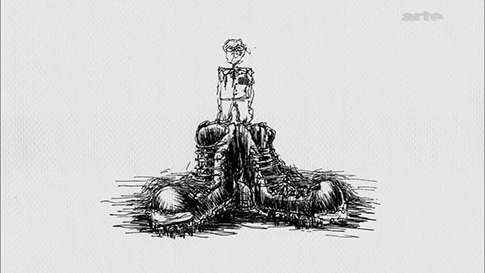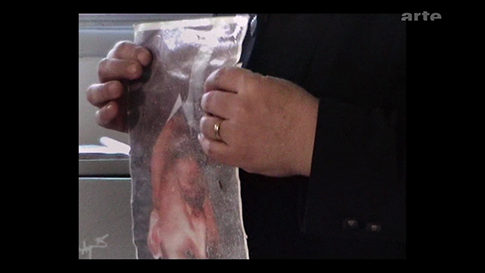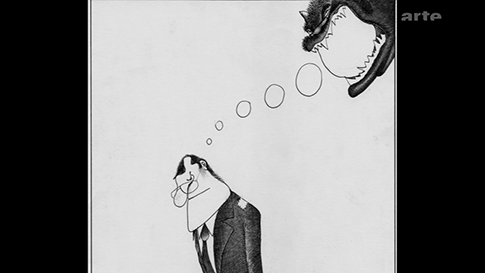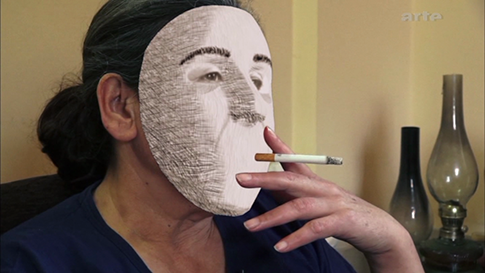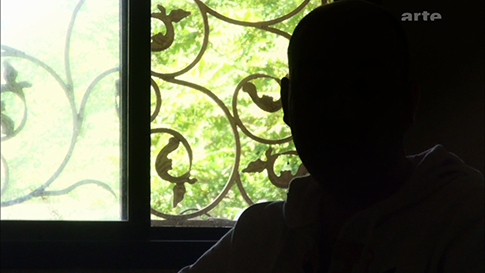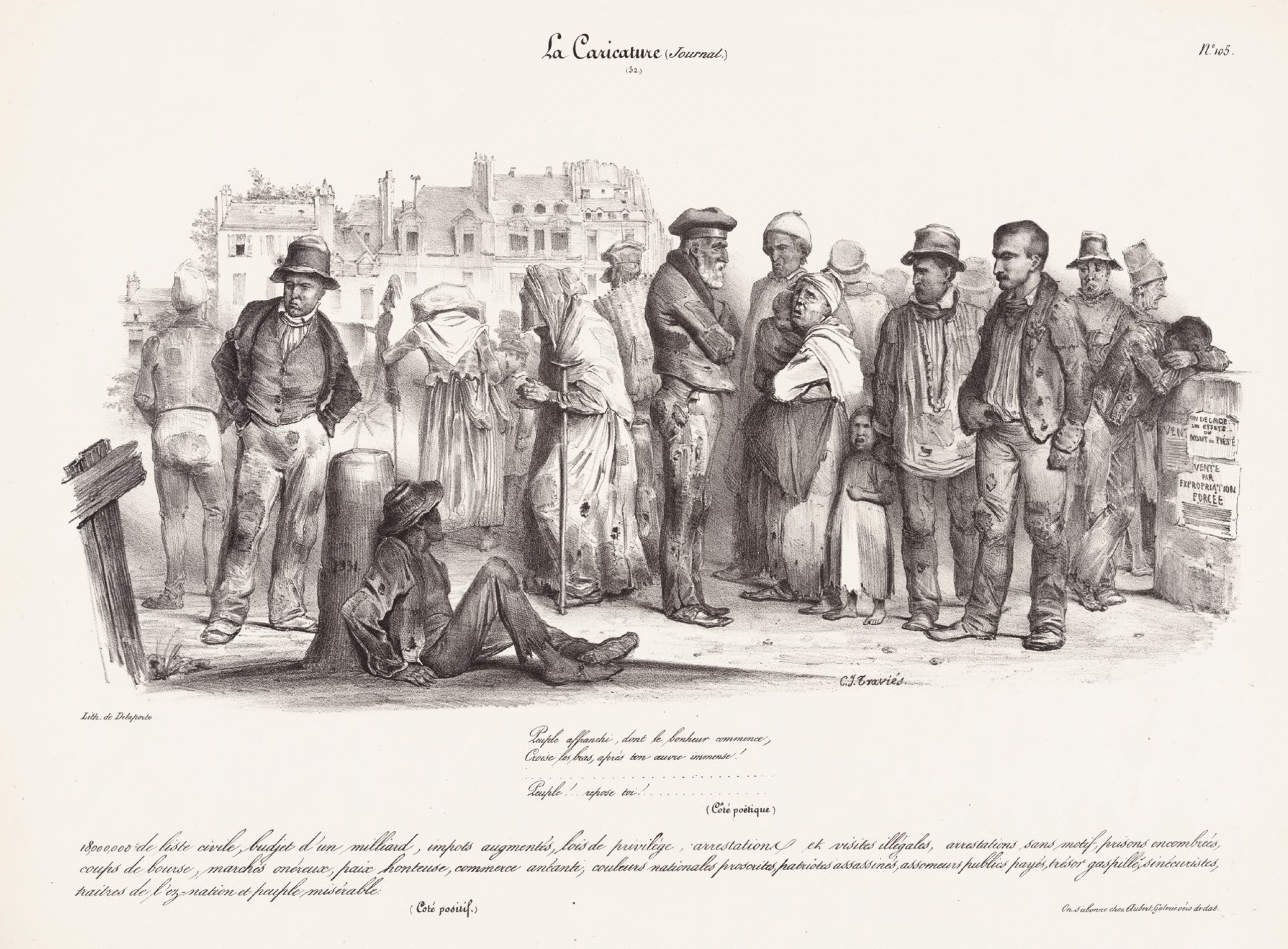Angela Matthies]
[June 12, 2015
Hazem Alhamwi´s “From my Syrian Room” — from his German room
The Essay is based on Hazem Alhamwi´s latest documentary “From my Syrian Room”, Syria, France, Germany, Lebanon and Qatar, 2014 , 70 minutes. All images are stills taken from this film.
Prima facie, there is no obvious close connection between the satirical black humour of Syrian artist Hazem Alhamwi, which is found in his cartoons, and the existential gravity of his apocalyptic drawings. Whereas political satire has its home, as illustrations, in the public domain, in newspapers, magazines and the internet, and is a political tool designed to sting in order to provoke change, Alhamwi’s drawings seem to firmly belong to the opposite spectrum of non-political art, alluding to destruction and a sense of constantly being watched by the multiple eyes, often belonging to strange creatures, hiding behind layers and layers of black lineature, partially scratched out, and then being drawn over again and again. To call them ironic would be very frivolous indeed. His cartoons seem to address the particular, a specific issue or problem of a specific society, featuring the face of Assad. His “existential” drawings seem to address, or rather express or allude to universal human emotions. The only connection between the two seems to be their respective lack of colour, a world in black and white.
However, even this alleged connection turns out to be somewhat coincidental. For Alhamwi was just not able to see colours in broad day-light for a long time, his eyesight being very poor. Only quite recently he had a new lens transplanted into one eye and thus adopted a new way of looking at the world. Nowadays, his drawings are in fact brightly coloured and have a “childlike“ quality to them, as he puts it. But the way I understand it, the seemingly banality of this connection may be what lies at the heart of Alhamwi’s concerns, among other things.
In order to explain, let me start at the beginning — again. I am meeting Hazem Alhamwi in an English-style café close to the station “An der Luftbrücke“ in Berlin to talk about his recent documentary “From my Syrian Room“. He has chosen this place, because it is not too far from the flat he is sharing with his wife Lama. In any case, it is a place with the appropriate name attached to it to talk about what it is like for an artist from Syria to be in exile in Germany and about the double responsibility he feels, both towards his home country and towards his new country, and the way he can connect the two in his mind. This responsibility that he says is commonly felt by exiles, after they realize they have survived, and gave him the energy to make his documentary films and to think about how he might be able to contribute to the effort of the people in Syria and abroad. And this while he is still drawing every day, a passion he has felt since childhood.
Since then, he has studied painting, theatre and film making and thus he is able to draw freely from all those media. He is both a visual artist and a film maker and has created award-winning documentaries, such as “Childhood of the place”, and his most recent “political” documentary about revolutionary Syria. His background helps him develop a complex approach for a complex issue: the distinctive mix of political, psychological, historical and personal narratives and ideas that make up the story of a society that is at war against itself at the time of filming, and at the same time of the person telling that story. But the drawings came first, and in a way, there was no political element to his art in the beginning. For the drawings were first created by Alhamwi in a Robinson-Crusoe type of situation, in the privacy of Alhamwi’s room in Syria. They were made available to a wider public in Alhamwi’s recent documentary, “From my Syrian Room“, when Alhamwi was already in exile in Germany, and during the short period of great expectations of quick change in Syria. The documentary, in the beginning, at least, makes it seem as if Alhamwi couldn’t know whether he would ever able to show his drawings to a wider audience, as if most of his drawings were the result of an almost solipsistic interaction with his own fears.
The question whether these fears are partly idiosyncratic fears of a sensitive child and to what extent they correspond to actual threats to his own life or the lives of others becomes mute when it is shown why instilling and encouraging those fears in children may be considered a crime as severe as other human rights violations. In the documentary, Alhamwi’s drawings are interspersed with interviews of friends, family members and fellow artists reacting to his drawings, as well as his reacting to, for instance, songs by a fellow artists about the children in Syria. So there is a lot of culture and art in Syria, even though the space may be limited. There is also a voice-over by Alhamwi, in which he comments on his own childhood in sometimes lyrical, sometimes sober ways. And the list of ingredients of the documentary doesn’t end here. Shots of nature (of both plants and animals), sometimes in extreme close-ups, sometimes rendered in quick motion are juxtaposed with images of cityscapes, of places, and of objects. It is not an objective view on the conflict in Syria and not a documentary about events that have taken place or are taking place, but rather a documentary that exposes its own subjectivity in a lot of places, both literally and figuratively and is maybe about the “what-it-is-like” quality of human experience in Syria, a view from the inside, again both literally and figuratively, at what seemed then to be a turning point in the history of the country, but, at least that is what it appears like in the beginning, not in the emotional life of Alhamwi.
Despite a medley of techniques and bits and pieces of material, Alhamwi’s documentary follows a clear structure: the chronological story, as reflected in the fates of family members and friends, of how the Arab Spring in Syria came into being. It is told how Hazef al-Assad, had come to power in 1970, how he was succeeded by his son Bashar in 2000, and how this story is connected to the story of the documentary maker himself, who, despite his yearning for freedom and a family history of suffering loss of job and long prison terms due to refusal to work with al-Assad, finds himself paralysed when fighting begins in the streets, and his countrymen finally rise to fight for their freedom. It is as important to find the roots for his fears and paralysis as it is to find the roots of the conflict in Syria and the state of society as a whole, for there seems to be an intrinsic connection between the two.
The story of Syria, as well as the story of his own inertia, and the documentary, they all begin with children and childhood. In the beginning of the documentary we listen to children singing and clapping in the court-yard of their school. They are forming orderly, military-like columns and clap and sing in unisono. They are thanking their leader al-Assad for bringing peace. However, when in 2011 some children painted anti-government graffiti on the walls of their school in the city of Daraa, they were rounded up and allegedly tortured. Thus the Arab spring began in Syria and the armed fighting against the army of Assad. The children Alhamwi is filming in the beginning of his documentary go to the same school he went to as a child. He tells tales of enforced conformity, and children learning to close themselves off from the world. He also tells a tale of violence and humiliation by a teacher as a reaction to being imaginative, and in fact, loving. There are other teachers, however, and especially one teacher of his childhood, that is described as caring and supportive of their students, and another one allowing Alhamwi access to the children when he is filming his documentary. It is not a black and white picture, and there often is a story rather than a recounting of facts, although the story is always factual. It is a documentary, after all.
Another story the documentary begins with is how Alhamwi came to eat one of his cartoons at the age of eighteen, on the brink of adulthood. He had just defiled the face of al-Assad in a cartoon, and thus defiled the leader himself in the context of the oppressive, controlling dictatorship.
(Later we hear another story of how one student was beaten, because he refused to hold up a picture of al-Assad during a parade on his birthday, a routine task.) When soldiers entered the bus he was riding at the time, he mistakenly believed that the soldiers had been made aware of the cartoon in his bag and had come for him. After a childhood filled with a sense of being watched all the time by a seemingly omniscient government and its secret police reaching into people’s most private spheres, he quickly chewed and swallowed the cartoon. He told the soldiers that it was a yummy piece of cake, thus telling a double lie, for in fact the ink tasted bitter.
In Alhamwi’s documentary, stories of this kind told by him or by the people he interviews illustrate the way children in Syria grow up in an atmosphere of fear and constant surveillance, just like his drawings and cartoons that are part of the documentary sometimes illustrate emotions of helplessness and hopelessness. Any authentic expression of thoughts, ideas and emotions in such an environment is highly dangerous, not worshipping the face of al-Assad is harshly punished, as are minor mistakes like forgetting one’s homework and being imaginative.
In 2003, Alhamwi arms himself with his first camera and he changes his profession from mostly being a painter to a documentary film maker. He returns to Syria in 2011 to give us a glimpse on how life feels like from the inside in the revolutionary days of Syria in 2011. It is very dangerous to film in Syria, even during the brief period of change, and he does get arrested when being observed leaving his house with his camera. In fact, giving people a voice, expressing real emotions and sharing stories in front of the camera must already be considered as an act of great defiance in this context. The footage accordingly had to be smuggled out of Syria, and the interviews are conducted in conspirational ways at unmarked locations.
On the one hand, the documentary is full of people’s “real” stories. There is the maternal uncle who was a leading figure in the Ba’ath party until it becomes clear to him that far from realizing the pan-Arabic dream of freedom, al-Assad uses violence to keep the people of Syria under his control. Alhamwi illustrates this with a cartoon depicting a face and the sole of a heavy boot, sharing the same profile. There is the woman who was a star pupil which brought with it the honour to sing the party songs, something she was very proud of then, but which she feels very ashamed of now. There is the daughter who despised her parents for their passivity, and through her own deeds endangered them. The documentary shows how the political situation has driven a wedge between families and friends, but it also shows a strong will to become active against the government, to work towards their freedom, at least in the year 2011, and especially in the younger generations. Alhamwi wants to tell the real stories of people and when telling their stories, he does not want to resort to the symbolism characteristic of an earlier generation of artists. The kind of symbolism that may be a natural reaction to a difficult reality, where speaking one’s mind in non-symbolic ways can carry long prison sentences, as is affirmed by more than one of the people Alhamwi talks to. That doesn’t mean that his documentary is not full of symbolism: it is in his drawings, but also in shots depicting every-day objects carrying symbolic meaning through the way they are combined with the narratives in the film, such as birds hanging from the ceiling in the school of Alhamwi’s childhood, and in front of shops in the city. They are inside, that is, outside their element and will not be freed. For even outside shops and driven by a motor they are only able to fly in the circle, that is allowed by the length of the string that attaches them to the ceiling. It is not clear, what sort of function those birds might have in the every-day life of people.
But even though Alhamwi’s language is thus symbolic in parts of the documentary, it is very clear that he does not want to be confined to some form of symbolism. Or rather, he wants to transform the universal language of people in pain and combine universal symbolism with something more individual. For retreating to symbolism is arguably a part of Alhamwi’s own reaction to the society he finds himself in, as is witnessed by his cartoons which depict barred eyes, small figures at the edge of an abyss pointed at by giant hands, broken drums, and so on. However, even something clearly symbolic like his barred eye has an individualistic touch: for instance, the bars pierce the eyelids in a way that makes it possible for the eye to blink, and they are all of different length and seem to be skilfully applied, almost like a beauty piercing. So while there is some allusion to torture, oppression, pain and imprisonment, there is also an allusion to beauty and choice. And how exactly do the bars affect the vision of the person peering out from those eyelids, or theted and the conflicted emotions they arouse? So on the one hand, it is important to Alhamwi to give individualistic touches to a seemingly universal and simple-”minded” symbolic
This also gives an answer to another question: whether the clips depicting Alhamwi’s drawings have one sole and intrinsic function in his documentary, for instance the one of providing a layer of symbolic meaning and a subjective viewpoint onto the actual, objective political situation, as recounted by family, friends and himself. And whether his cartoons have the one and only funcas he himself would say, for a range of different purposes. In the framework of the documentary, Alhamwi’s drawings thus provide content, and are themselves content , illustrate, interpret, translate the narratives and stories of the interviewees as well as his own, give political commentary, are expressions of individuality, provide a way to feel free and stay sane, and a way to communicate and connect with other people, other artists and friends who watch him draw and comment on his drawings. Like an “imagetrack“ they also create atmosphere. They are rediscovered and looked at the way the artist himself wants us to look at them, with Alhamwi’s camera often focussing on a detail of a cartoon before showing us the whole picture, or walking us through his complex and detailed drawings. At the same time, the documentary also makes it very clear that the drawings are also to be looked at just like any other material objects would be looked at, objects such as chairs and screwdrivers, and also cameras, and are thus qua objects also part of the complex struggle in Syria like guns and crumbling buildings. They provide content and a point of view on events, but are also themselves part of some of the events that need to be interpreted. For instance, they are eaten and discovered to taste bitter. They are tools like guns are tools, just with a wider, albeit slower-working range of applications. The documentary, in fact, never shows visuals involving guns or scenes of violence. We do hear the sounds of war, but the soundtrack of war is illustrated by nature shots, growing plants for instance, which could have been filmed in a variety of locations. This is in accordance with Alhamwi’s aim to suggest non-violent, “organic“ ways of resolving the conflict, or contributing to creating a future for Syria. He claims that he learned the kind of patience needed for this approach from his tortoise, itself a major character in his documentary. Only in the end of the documentary we do see how people live on the streets in Syria, while the war is going on, with a cello played by a young woman in the background. This time the soundtrack offers a sense of hope.
While we are still sitting in the café he explains his take on the relationship between politics and art. Both are trying to affect change, but art has a slower, more long-term perspective and tries to change human beings from the inside by means of providing outlets to tell their individual stories and show their faces. He believes that as an artist from Syria he has to take a stand, but can only do so with the weapons he has: experiences of the redemptive features of art which he thinks could help a traumatised generation, or generations, in Syria, children that have been betrayed of their childhood. The documentary thus ends on a more hopeful note, with the girl playing the cello, maybe suggesting that even in the middle of war, there are resources in Syria available for the sort of change Alhamwi has in mind. Art can also help to understand the more “universal” roots of the current conflict, which is one of the main goals of Alhamwi’s documentary. By being an antidote to oppression, to any oppression by any people by anything, it reveals something about the nature of oppression.
Later, when it became clear that al-Assad Junior was not going to abduct so readily some people that Alhamwi had interviewed for the documentary requested that their faces be rendered anonymous. This was partly achieved by means of drawn and animated masks that show only people’s eyes. And thus another application of Alhamwi’s drawings is created: art as a disguise, a way of providing individualized masks. This is another complex layer to an already complex answer to the question which role art, and Syrian artists play in the liberation of Syria. In a similar vein, art probably saved Alhamwi from prison, when he was arrested after he was seen leaving his house with a camera, something highly suspicious. Fortunately, it was an art project of his at the time was to document decaying bath houses in Damascus. There was enough footage on the camera featuring bath houses that the secret police believed he was just a harmless artist. Just as Alhamwi’s interviewees hide behind his art, so does the original footage for an art project hide behind footage for another art project. The mistake of the police clearly consisted in the assumption that there is such a thing as harmless art. What Alhamwi seems to be saying, both explicitly and by means of the formal properties of his documentary so is: there is no way of clearly separating vastly different phenomena from each other. There is not one single function a certain technique, or “tool“, as he puts it, can serve, and there is not one single cause of developments in society. Making connections between tools and their application, and between stories and events, and between symbols and their meanings is a conventional/universal, as well as an idiosyncratic/individualistic activity. So there are different ways of creating histories, both personal, societal and “cosmological“ (for want of a better term), by means of visual art, for instance, but also by means of poetry or music, or by means of technology.
After having finished eating and also listening to some live music in the café, Hazem shows me his working space in Germany, his German room, full of suitcases and art supplies, in which he still draws every day. Just as in his documentary, he also uses different tools for his drawings and paintings, tools that come from a range of conventional usages, from the cosmetic, as well as the cooking industry. He is fascinated by technology in Germany in general and how it could be used for his aims, to contribute to the freedom of people in Syria. I thus get to hear some of his plans for the future, besides building a life in Germany starting with obtaining a bigger room, something he really needs. His vision is to work together with other Syrian artists, writers and translators, to produce illustrated children’s books in Arabic like the ones he has come across in Europe, which are designed for generations of children growing up in a more open, democratic society. He wants to help a lost generation of children in Syria, traumatised by the dictatorship and the violence of civil war. He envisages a marriage of German technology and financial support and the work of artists like himself to bring about change, the slow change afforded by art.
The documentary, with all its bleak elements, ends on a profoundly hopeful note as well, by pointing out that it was children who had started the revolution, who “saved us”, as he puts it in his voice-over, and who also present an opportunity for change, and making new meaningful connections.
Thus I get back to the observation of a seemingly unimportant detail that I mentioned in the beginning: the connection between Alhamwi’s poor vision and his drawings in black and white.
After we have finished talking, Alhamwi allows me to study his newest paintings which he has earlier on described as “childlike” and as reflecting his authentic emotions. So there is a connection to his plans to do illustrations for children’s books. There is also the connection to the way he has approached the civil war in Syria, namely by retracing the story and symbols of his own childhood. There is of course the obvious connection to the conventional symbolism of colour, with the colour black of his earlier drawings standing in stark contrast to the colorful (and playful) newer drawings (there is certainly a very different “vibe” we get from his newer, brightly coloured drawings, possibly intended for a young audience). But there also remains the connection to his earlier vision problems. And while this connection does not seem to express some deep meaning, certainly not a meaning as “deep” as one referring to colour symbolism, the fact that an art teacher wondered about Alhamwi’s preference for black and white drawings, but never asked about it, does. There was simply no space in Alhamwi’s Syrian childhood for random quirks of the kind that belong to unique personalities. The kind focused on by Alhamwi’s individualistic realism that does not shun away from symbolic meanings, but emphasizes the way they often combine universal and individualistic elements. Some connections are meaningful simply because they are made by human beings, or a human being, a bestower of meaning. This is one of the universal truths Alhamwi is interested in, a renewed focus on individualism as an antidote to political, psychological, symbolic, or, in fact, any type of oppression. In fact, Alhamwi’s documentary, which is based on both loosely associated material and random-seeming observations and highly controlled and formally thought through elements, can be seen as an attempt to focus on individual features and quirks in the context of universal features and truths, both quirks of nature and of people, and also of “individualized” symbols, all of which the regime has tried to eradicate by teaching children from a young age to conform and learn what they have to feel (or, rather; what they have to say they feel), the shapes of their faces being a result of the shape of the boot that kicked them, as is depicted in one of Alhamwi’s cartoons. The individual feature in this cartoon being the way the eyes, or rather, the gaze, is handled as an add-on, as if their gaze, their point of view, was hanging in the air as a result, not connected to the the physical realities around them.
The unique quirks of people, places and objects have intrinsic value, and it is one role of art to express this individuality. Things may be connected simply because someone connected them and found their connection meaningful. It is this freedom that the dictatorship undermines. The dictatorship prescribes what its subjects should feel or connect, it destroys the individual story of very different people, their unique faces. So instead of focussing on whether and which of Alhamwi’s drawings are making political statements or are addressing existential issues, we should rather focus on the details that he reveals about his childhood and himself as a person and see them in contrast to and context of the details of the whole situation: the historical situation, his family situation, his personality. His documentary is fundamentally neither about politics, nor history, nor existentialist themes. It is about seeing differences and individuality as opposed to the faceless masses the Assad regime, has produced over the years.


